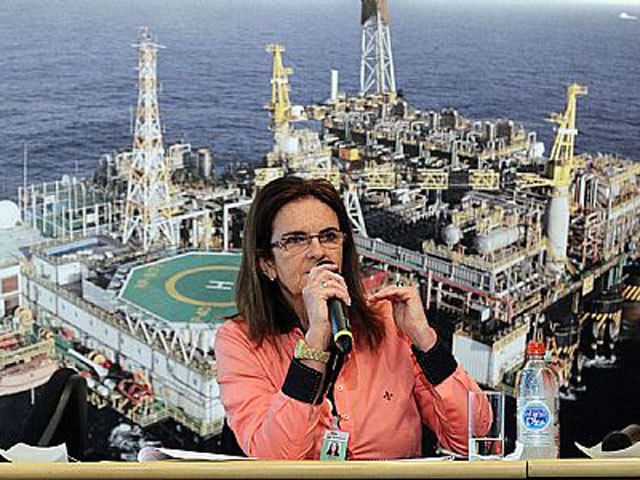
Petrobras is considering selling assets to help buffer the state-run oil producer from an estimated $6.7billion in additional payments to the Brazilian government over the next five years.
Petrobras shares fell the most in six weeks on Tuesday as exploration success at one of its biggest deep-water prospects off Brazil signaled billions of dollars of additional expenditure for the world’s most indebted producer.
The company could sell as much as $11billion in assets over the next five years, according to a presentation made to reporters on Tuesday.
Other options include restructuring some projects to reduce expenditures, chief executive Maria das Gracas Foster said. The company has already sold exploration assets in regions including the US Gulf of Mexico and Africa to help finance efforts to more than double production by 2020.
Petrobras will have to pay 2billion reais ($900million) this year to tap more crude at its giant Buzios field and surrounding areas than its license authorizes, the Rio de Janeiro-based company said in a statement.
The government expects to receive an additional $5.9billion from 2015 through to 2018 as part of a production-sharing arrangement based on projected future output that is expected to peak at one million barrels a day in 2026.
Shares slumped 3.6%to 17.64 reais yesterday, the biggest drop since May 8. It was up 3.2% before the announcement.
In 2010, Petrobras paid $42.5billion in shares and cash for the rights to produce 5billion barrels at a section of the pre-salt region that holds the Buzios field in deep waters of the South Atlantic.
The area holds 9.8billion to 15.2billion barrels of recoverable oil in addition to what Petrobras was authorized to produce under the original contract, it said in a statement.
“This is a great opportunity for Petrobras,” Foster told reporters in Rio de Janeiro. “No other company in the world has the opportunity to work with such great volumes.”
Petrobras has found as much as four times the amount of crude that it is authorized to produce at the offshore license. The company is already struggling to develop all the oil it has found in other sections of the pre-salt region and investors are more eager to see the company increase output than make discoveries after output has remained flat for the past four years.
It is the first time Petrobras is making “advanced payments” for an oil project, Foster said. The company will not seek partners for the new area, and high well productivity will reduce the amount of platforms needed to develop the area, said Jose Formigli, the head of exploration and production.
While the contract gives Petrobras $15.6billion in net present value, the payments add financial risk, Bank of America analyst Frank McGann wrote.
The project should have a 15% internal rate of return, lower than the 18% return Bank of America projects for the Libra pre-salt field where Petrobras also has a profit-sharing contract, he wrote.
“The transaction is very mixed in our view,” McGann wrote. “This is likely to be viewed as one more sign of a heavy government involvement in the company, which is likely to offset any potential long-term benefits.”
The surplus area probably will start producing by 2020 or 2021, Oil and Gas Secretary Marco Antonio Almeida told reporters in Brasilia.
“If Petrobras had the financial capability, we would charge 15billion reais upfront,” Almeida said.
“We are providing Petrobras with a great oil area to explore.”
Production under the contract will add an additional one million barrels a day to the company’s production curve, Foster said. There are no limits on how much Petrobras can produce under the profit-sharing contract, Formigli said.
Petrobras is investing about $100million a day to expand its capacity to produce and refine crude, contributing to the biggest cash flow deficit of any oil company, according to data compiled by Bloomberg.
